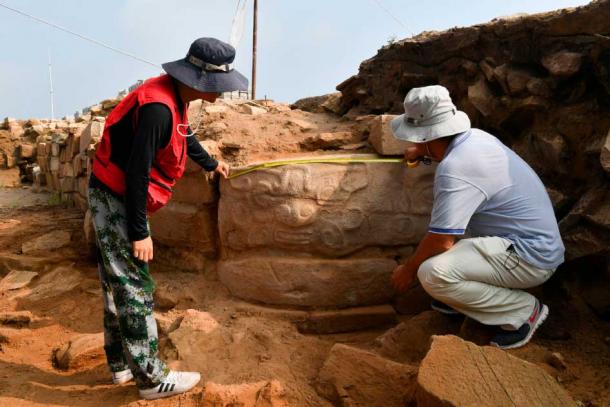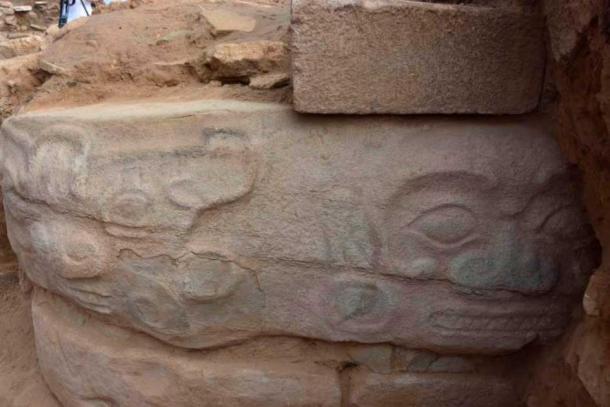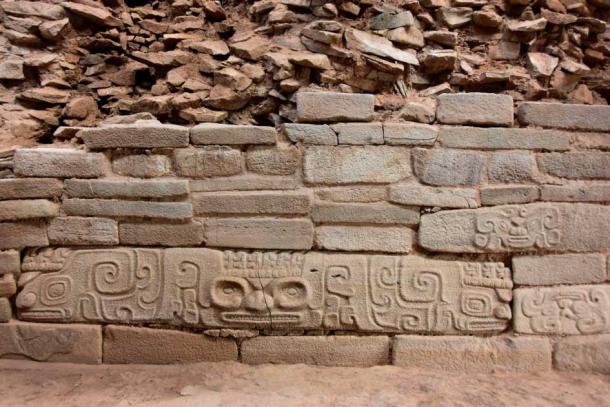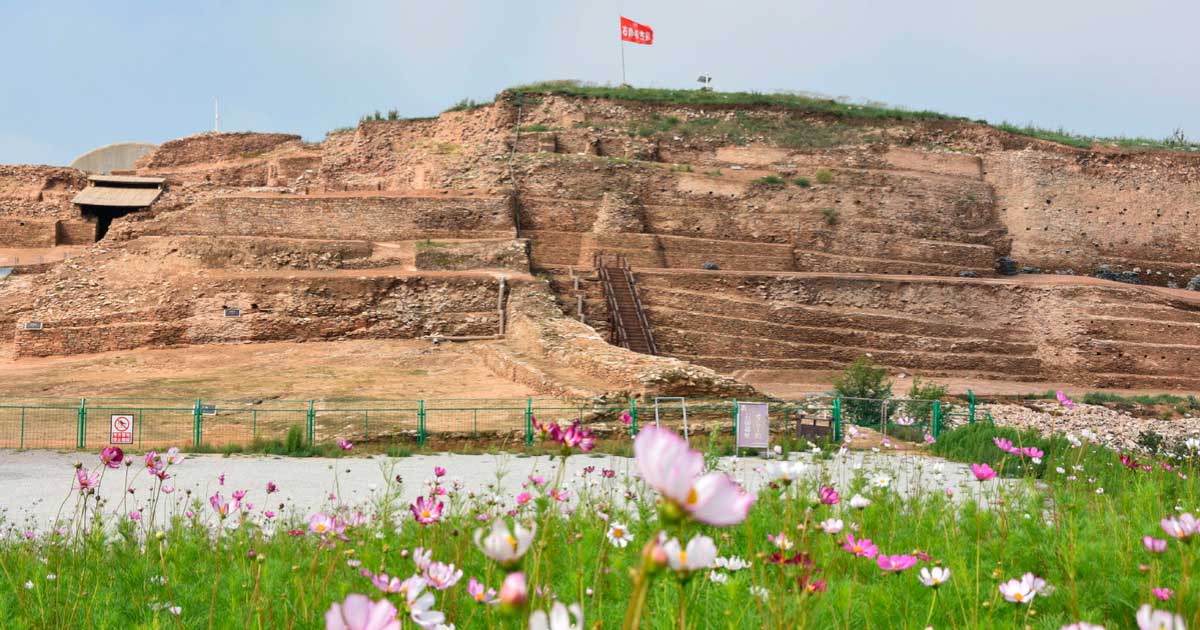King Carved In Stone Found at 4,200-Year-Old Chinese Pyramid Palace
A team of archaeologists have potentially found the portrait of a king carved into stone at the base of a massive prehistoric pyramid complex in northwest China. At more than 70 meters (230 feet) in height, the 4,200-year-old Shimao Chinese pyramid in Shenmu, Shaanxi province is roughly half the height of the Great Pyramid at Giza, which was built at the same time.
A Chinese Pyramid in a Gigantic Forgotten Walled City World
The archaeological site of Shimao is located in the northern part of the Loess Plateau, bordering the Ordos Desert. Shimao is often referred to as “The Chinese Pyramid of Civilization,” because it is the largest late-Neolithic archaeological site in China. Dated to around 2000 BC, towards the end of the Logshan period, the site covers a whopping 400 hectares (988 acres).
This Chinese pyramid structure wasn’t religious, instead it was the base for a grand palace that sat on the flat top of the pyramid. This gigantic palace at the top of the pyramid was the size of 10 football fields or 861,112 square feet (80,000 square meters). It overlooked a walled city, which was 50 times bigger than the palace area. Recently, a garden pool where crocodiles were kept was also discovered within the same palace complex.
The base of the pyramid has more than 70 stone carvings of human faces, animals, and mythical fantastical creatures.
- Shimao City Ruins: This Massive Prehistoric Site Rewrites Chinese History
- Who Were the Mysterious Neolithic People That Enabled the Rise of Ancient Egypt?

This stone face could be the face of the Chinese pyramid city ruler or another elite that ruled in this ancient Neolithic metropolis. (China Daily)
The city that surrounded the Chinese pyramid palace had courtyards, streets, and public squares which were built with stone, reports the Chinese state agency Xinhua. In fact, Shimao is the largest known walled site of the period.
The Shimao Chinese pyramid palace and city was originally believed to be a section of the Great Wall of China. However, ten years ago archaeologists found jade pieces in the area, which led to an extensive archaeological survey of the pyramid site. It was soon dated to the late Neolithic period and proven to be the biggest Neolithic site ever found in China.

Two of three faces have been excavated by archaeologists. (Xinhua)
Who Ruled The Chinese Pyramid Palace City?
DNA analysis has been carried out at the site, which proved most residents of the Chinese pyramid metropolis were Chinese. The identity of the ruling class, however, remains a mystery as this ancient civilization simply and suddenly vanished 3,800 years ago without leaving any written records, reports South China Morning Post.
This was at the time of the Xia dynasty (2070-1600 BC), which is historically renowned for bringing in dynastic succession to ancient China, and the first Chinese government of sorts. "The site's early date and peripheral location were surprising since Chinese civilization was thought to have first developed in the Central Plains around 500 years after Shimao's founding," said the research team.
- Tests Prove Largest Neolithic Circle in Britain was Definitely Human-Made
- Neolithic DNA Reveals Surprising Truth of the Yamnaya Culture in Europe
Deputy lead archaeologist of the excavation team, Professor Shao Jing from the Shaanxi Academy of Archaeology, is excited about the probable portrait of a king found at the site that could answer the ruler mystery.
“The face on the west side is about 80 cm (31 inches) long and 50 cm (20 inches) high with a crown on its head. It is the largest single image in the Shimao stone carvings. The eastern face that has been unearthed appears to be in the center of the whole group … and may be the image of the king of the Shimao ancestors,” said Professor Shao.
He is referring to the giant 2-meter carved stone wall with three faces, of which only two have been completely exposed. The elite portrait of the city’s ruler is carved into blocks of a wall section. The carving of the king is distinctive as it has “arc patterns on the outside of the eyes.” Other solemn human faces are adorned with earrings, with protruding eyes and mouths, and visible teeth.

Another of the many carvings from the late-Neolithic-period Chinese pyramid palace at Shimao in northwest China, which is now the largest late-Neolithic site in the country. (China Daily)
Were Global Communication Channels Used Before Civilization?
The animal portraitures and stone carvings do suggest an element of spirituality to the entire structure. Perhaps these fantastical creatures and animals were carved in stone to protect the king, in both the current life and the next. What is most interesting to note is that roughly at the time this civilization disappeared, other ancient civilizations also vanished mysteriously. This most famously includes the Indus Valley Harappa-Mohenjodaro civilization and Mesopotamia.
There is some commonality in the way these late-Neolithic-period stone structures were organized. Artifacts found at these sites, the jade pieces, for example, at the Chinese pyramid city, along with musical instruments that have been identified in over 100 places across the world, suggest an effective communication amongst elites some 4,000 years ago. This line of thought is fascinating and could open up a wide variety of historical research.
Top image: The center of the late-Neolithic-period Chinese pyramid palace city slowly emerging from the landscape it became part of thousands of years ago. Source: China Daily
By Sahir Pandey
References
Altuntas, L. 2022. Archaeologists unearth a portrait of a king carved into stone in a 4,300-year-old Chinese Pyramid. Available at: https://arkeonews.net/archaeologists-unearth-a-portrait-of-a-king-carved-into-stone-in-a-4300-year-old-chinese-pyramid/.
Chen, S. 2022. Scientists find what could be the face of a king at an ancient pyramid in China. Available at: https://www.scmp.com/news/china/science/article/3188152/scientists-find-what-could-be-face-king-ancient-pyramid-china.
WION. 2022. In pics - Face of a king found on a wall in an ancient pyramid in China. Available at: https://www.wionews.com/photos/in-pics-face-of-a-king-found-on-a-wall-in-an-ancient-pyramid-in-china-505693#shimao-stone-carvings-505679.
Xinhua. 2022. View of prehistoric site Shimao ruins in NW China. Available at: https://english.news.cn/20220807/22bf8b012b3844fc89cfdbdf5bc34e9f/c.html.




















Comments
Do they all fall into the trap of dating the ruins at the time they were RESETTLED by completely different people? Most likely, the cultural complex was decimated (along with the people) in the same calamity that destroyed Atlantis, the Indus Valley, etc., and brought the sudden emergence of the Ice Age (circa 120-130k years ago).
Nobody gets paid to tell the truth.